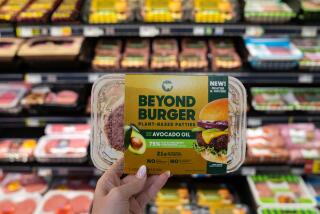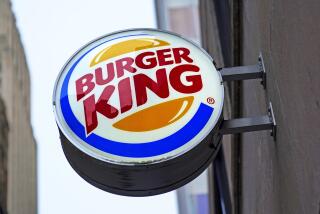Marketing Efforts Have Failed to Beef Up Industry’s Image
Nobody really needs to remind beef producers that they have an image problem. But they recently got a swift kick in the rump roast, anyhow, and they paid dearly for it.
An $800,000 study funded by the $62-billion industry urged beef companies to work together to reverse the slide in sales and try to recapture the huge portion of the market that has gone to lower-priced, better-marketed poultry.
“One reason the chicken people have been so successful is that they are fully integrated and can control the quality,” said Barbara Cohen, vice president of the consulting firm Booz Allen & Hamilton Inc. in Chicago, which conducted the study. “The beef industry does suffer from inconsistency.”
Advertising, the report said, must do more than simply raise awareness of beef. Messages should promote product variety, health and convenience and persuade people to start buying meat again. A good start, Booz Allen said, would be to offer leaner meat, so that consumers aren’t paying for unwanted, unhealthy fat.
The industry’s past advertising efforts have had mixed results. In 1987, as beef sales were skidding, the industry embarked on a high-profile campaign to raise consumers’ awareness of beef, funding it with a $1-per-animal fee. The early ads backfired.
A 1987, $23-million “Real Food for Real People” television ad campaign featuring James Garner and Cybill Shepherd raised awareness all right. But it got shelved after Shepherd was quoted as saying that she never touched red meat and Garner was sidelined with heart trouble.
The latest phase of the “Real Food” ads showcases beef as a low-calorie food of choice for folks in such whimsically named places as Manhattan, Mont.; Yale, Wash., and Luck, Wis. Booz Allen noted that those ads are especially popular with ranchers, who already eat beef.
Booz Allen even recommended a one-year moratorium on advertising to allow time to beef up the industry’s advertising allotment and devise an entirely new campaign.
But branded programs--in which beef producers sell their products under their own labels rather than generically--might not be the answer, either, as Excel, the industry’s third-largest producer, found out.
In February, after five years in a cooperative effort with Kroger food stores, the Cargill subsidiary removed its branded Excel beef from the market. The product failed for two prime reasons, industry people say.
For starters, Excel, based in Wichita, Kan., used vacuum packaging to extend the beef’s shelf life. Without oxygen, the “red meat” turned nearly purple, and consumers got turned off. Moreover, Kroger meat cutters, feeling that their jobs were threatened because the beef arrived from Excel ready for the meat case, did not support the program.
More to Read
Inside the business of entertainment
The Wide Shot brings you news, analysis and insights on everything from streaming wars to production — and what it all means for the future.
You may occasionally receive promotional content from the Los Angeles Times.











